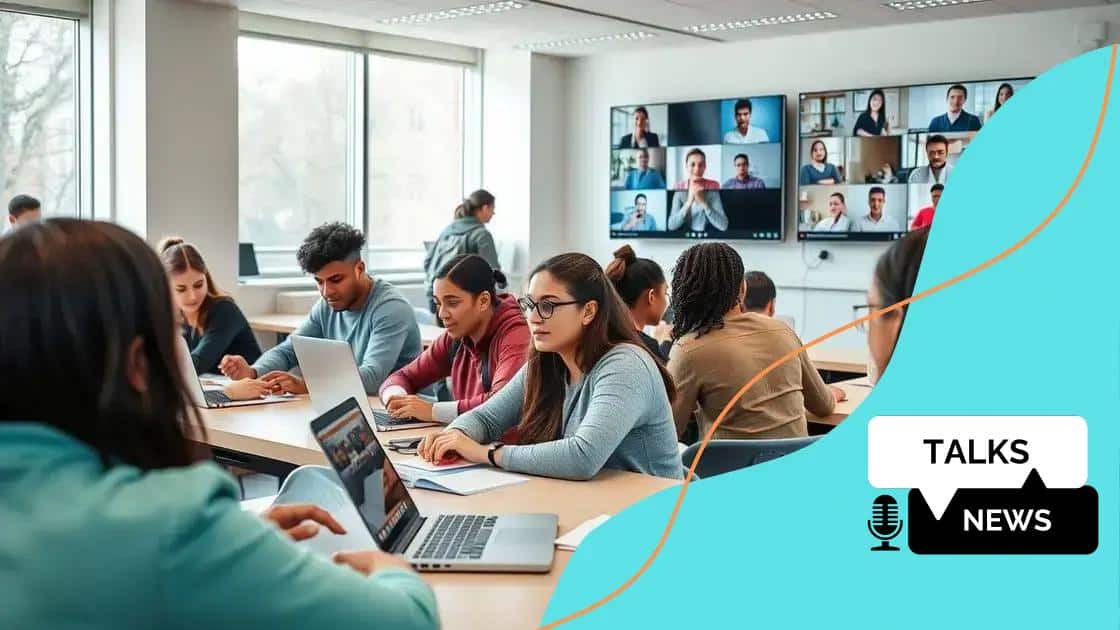Hybrid learning models for college students: a new approach

Hybrid learning models for college students combine in-person and online education, providing flexibility and personalized learning while addressing challenges such as technology access and student engagement.
Hybrid learning models for college students are changing the way we think about education. Have you ever wondered how mixing online and in-person classes could enhance your learning experience? Let’s dive in!
Understanding hybrid learning models
Understanding hybrid learning models is crucial for adapting to modern education. These models combine traditional classroom teaching with online learning, providing flexibility and diverse learning opportunities.
In a hybrid approach, students can attend classes in person or participate virtually. This flexibility caters to different learning styles and schedules.
Key Features of Hybrid Learning Models
There are several important aspects that define hybrid learning models. These include:
- Blended environments that integrate both online and face-to-face instruction.
- Asynchronous and synchronous learning components.
- Use of technology to enhance the learning experience.
With hybrid learning, students can engage in discussions with peers and instructors either in person or through digital platforms. This setup encourages collaborative learning, allowing students to connect in various ways.
Benefits of Understanding Hybrid Learning
Grasping the concept of hybrid learning models can lead to several benefits:
- Improved flexibility in managing academic commitments.
- Access to a wider range of resources and materials.
- Opportunities for personalized learning experiences.
As students navigate their educational journeys, understanding these models helps them make informed choices. By knowing how to mix physical and digital resources, they can enhance their learning outcomes. This approach helps in creating a balanced academic life where education adapts to the needs of each learner.
Benefits of hybrid learning for college students
The benefits of hybrid learning for college students are significant and transformative. By blending online and in-person education, students gain access to a more flexible and engaging learning experience.
One major advantage is the ability to learn at their own pace. With online components, students can revisit lectures and materials anytime. This flexibility allows them to fully understand concepts before moving on.
Enhanced Engagement
Hybrid learning also promotes enhanced engagement by offering various ways to participate. Students can join discussions online or in person, making it easier to connect with peers and instructors.
- Interactive online tools foster collaboration.
- Live-streamed lectures allow real-time participation.
- Social connections can be formed through both settings.
In addition, students can tailor their learning environments. Some may prefer the structure of attending classes in person, while others thrive in the flexibility of online formats. This adaptability meets diverse needs.
Time Management Skills
Utilizing a hybrid system teaches important time management skills. Students must balance their schedules, prioritize tasks, and set goals for their studies. These skills are essential for future careers.
- Learning to juggle assignments from both formats enhances discipline.
- Time management prepares students for workplace expectations.
- Students enjoy autonomy in organizing their learning schedules.
Ultimately, the hybrid learning model cultivates resilience and self-sufficiency in students. As they navigate challenges, they develop a strong sense of confidence that will aid them in all aspects of life.
Challenges of implementing hybrid learning

Implementing hybrid learning presents several challenges for both educators and students. While this model offers flexibility, it also requires careful planning and adaptation.
One major challenge is ensuring that technology is accessible to all students. Some may not have reliable internet or the necessary devices, creating a barrier to participation. Schools must work to provide these resources to ensure equal opportunities for every learner.
Technical Issues
Technical problems can disrupt the learning experience. Students might face issues like:
- Inconsistent internet connectivity.
- Software glitches during online sessions.
- Lack of technical support for troubleshooting.
These problems can lead to frustration and hinder effective learning. Educators must be prepared with backup plans to minimize disruptions.
Engagement Levels
Another challenge is maintaining student engagement in a hybrid environment. When learning online, students might feel isolated and less motivated to participate actively. To combat this, educators need to create interactive and engaging content that encourages participation.
- Incorporating discussion boards and group projects can foster interaction.
- Using multimedia resources keeps lessons interesting.
- Regular check-ins help track student engagement and feedback.
Lastly, training teachers to adapt to hybrid teaching methods is essential. Educators may need support in using new technologies and teaching strategies effectively. Continuous professional development can help create a confident and skilled teaching staff.
Effective strategies for successful hybrid learning
Effective strategies for successful hybrid learning can significantly enhance student outcomes. By combining online and in-person elements, educators can create a dynamic learning environment.
One key strategy is to foster clear communication. Students should understand expectations, schedules, and how to access resources. Regular updates through emails or learning platforms keep everyone informed and engaged.
Utilize Technology Wisely
Incorporating technology effectively is essential in a hybrid setup. Educators can use various tools to enhance learning experiences:
- Learning management systems (LMS) for organizing materials.
- Video conferencing tools for interactive sessions.
- Online quizzes and forums for student engagement.
These tools can support collaboration and provide students with resources to succeed.
Create Engaging Content
Content should be engaging and interactive. This can include videos, interactive simulations, or group projects. Visual aids help students grasp concepts better and maintain interest.
- Gamification can make learning fun and competitive.
- Real-world applications of lessons encourage critical thinking.
- Encouraging group discussions can deepen understanding.
Encouraging student interaction is vital. This may mean setting aside time for group activities or discussions. This builds a sense of community among students, whether they are online or in-person.
Another effective strategy is to provide personalized support. Offering one-on-one help or feedback tailored to each student’s needs can enhance their learning. This support ensures that students grasp the material and feel valued.
Future trends in hybrid education
The future trends in hybrid education are shaping how students learn and interact. As technology evolves, so do the methods and strategies used in classrooms.
One significant trend is the increased use of artificial intelligence (AI). AI can personalize learning experiences based on student performance. This means students can receive tailored resources that meet their specific needs, enhancing understanding and retention.
Adaptive Learning Technologies
Adaptive learning technologies are becoming more common in hybrid models. These tools adjust the difficulty of lessons based on a student’s progress. Benefits include:
- Identifying strengths and weaknesses quickly.
- Providing targeted interventions for struggling students.
- Encouraging independent learning at a comfortable pace.
Learners will be engaged more actively in their education, as these technologies allow them to take ownership of their learning journey.
Blended Learning Communities
Another future trend is the creation of blended learning communities. Students will connect more with peers and teachers, whether they are online or in-person. This trend promotes collaboration and support. Some ways to foster these communities include:
- Regular virtual meetups or study groups.
- Collaborative projects that bring together students from different locations.
- Creating discussion forums for sharing ideas and resources.
Moreover, the integration of virtual reality (VR) in education is on the rise. VR technology provides immersive learning experiences. Students can explore historical sites, scientific concepts, or artistic environments without leaving their homes.
As these trends develop, continuous professional development for teachers will also be essential. Educators will need training in the latest technologies and pedagogical approaches. This ensures that they can effectively implement hybrid education strategies for maximum student benefit.
hybrid learning models provide many benefits while also posing some challenges. As we look to the future, utilizing technology, fostering engagement, and promoting community will be key. By focusing on effective strategies, we can create a more accessible and dynamic learning environment for all students. Continuous improvement and adaptation will ensure that hybrid education meets the needs of future learners.
FAQ – Frequently Asked Questions about Hybrid Learning Models for College Students
What are hybrid learning models?
Hybrid learning models combine in-person and online educational experiences, allowing students to benefit from both settings.
What are the main benefits of hybrid learning for college students?
Hybrid learning offers flexibility, personalized learning experiences, and the ability to access diverse resources.
What challenges do educators face with hybrid learning?
Challenges include ensuring technology access, maintaining student engagement, and providing adequate training for teachers.
How can technology enhance hybrid learning?
Technology improves hybrid learning by facilitating collaboration, providing adaptive learning tools, and enabling interactive content that keeps students engaged.





